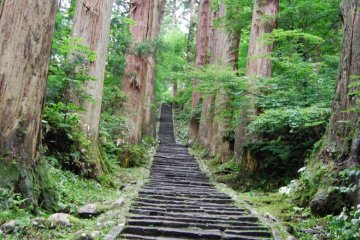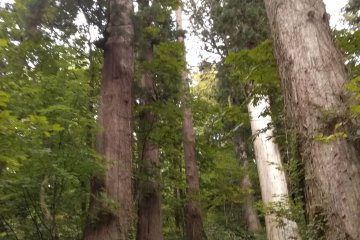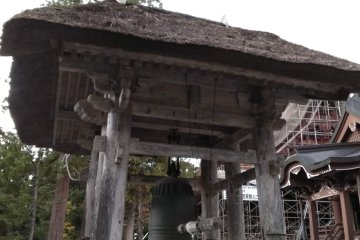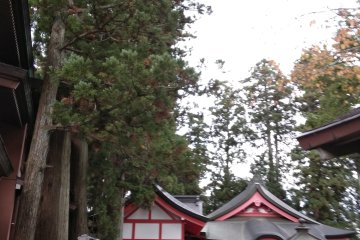The climb up the 2,466 steep and narrow steps to the top of Mount Haguro is a breathless affair. Out of breath, however, heart pumping, tendons stretched, there is no turning back. There is a magnet pulling us up, the clarion call of Sanjin Gosaiden. This Shrine is one of three belonging to the Dewa Sanzan, the Three Sacred Mountains of Dewa, Gassan, Haguro, and Yudono.

Each mountain shrine is dedicated to a segment of our life cycle of past, present, future. Esoteric interpretations abound for the meaning of each. Put simply, at Gassan, our past is the main issue, Haguro is where we confront our present lives, and Yudono is the hope if any for the future. Each shrine has its own deity, with Haguro the strongest in power and popularity, and regarded as the holiest because all three deities join forces at Sanjin-gosaiden.
Haguro is also the most accessible all year round. It is only 1.8 km, at the lowest altitude of 414 metres, although this is hard to believe when your body is stretched every which way. But the aisle of thick, towering, 1,000-year-old cedar forests, is nothing short of inspirational, and ancient Massha shrines, each dedicated to a different Shinto god, provide rest stops.

Matsuo Basho* in 1694 described Haguro as filled with miraculous inspiration and sacred awe. We can add to this the feeling of a strong sense of history, rooted in spiritual and religious beliefs lasting well over 1,000 years. Little can beat walking on steps constructed in 1648 that took 13 years to complete. There are marvels to see along the way, a historic tea house, Basho’s Monument, but the most welcome is the torii gate that tells us we are at Sanjin Gosaiden.
No going into the Shrine as per usual for holy sanctuaries, but the exterior of the Shrine is imposing enough to enclose us in an atmosphere of reverential quiet. The shrine’s original mainly cedar wood architecture and structures remain intact since 1818, with the red lacquered exteriors a contrast with white carvings of dragons and mythical beasts. Outstanding is Sanjin Gosaiden’s roof, the thickest thatched in Japan, over two metres thick.
Much is made of the Mirror Pond or Lake Kagami on the Shrine's grounds, but it was a bit sludgy for my time, three days after Japan reopened. People still pray here, for since the early days, pre-temple entry ablutions were performed here. People would also throw copper and bronze mirrors in to weigh down their prayers. Hard to ignore is the mammoth temple bell with the same thatched roof as the Shrine. It is a commanding presence, the largest cast iron bell in northern Japan, and the third largest in Japan. Its founding date 1275 is etched in.

A large red lacquered shrine, Raisenden, represents Dewa Sanzan’s dedication to the spirits of the departed, for Dewa Sanzan is where the spirits head for. Talk about atmosphere. Many smaller shrines and holy sites also make a mark, some edging the mountain side. Fresh flower offerings speak of continued worship.

There is a Tower of World Peace on Sanjin Gosaiden’s grounds, a large marble ball mounted on a pillar. It was erected in 1949 to promote the universality of all religions, the religion of peace for all. Basho* believed that Haguro’s...glory will never perish as long as man continues to live on earth. As long as there is Peace on Earth.
*Matsuo Basho quotes are from The Narrow Road to the Deep North and Other Travel Sketches, Penguin Classics, 1966, p. 124.











